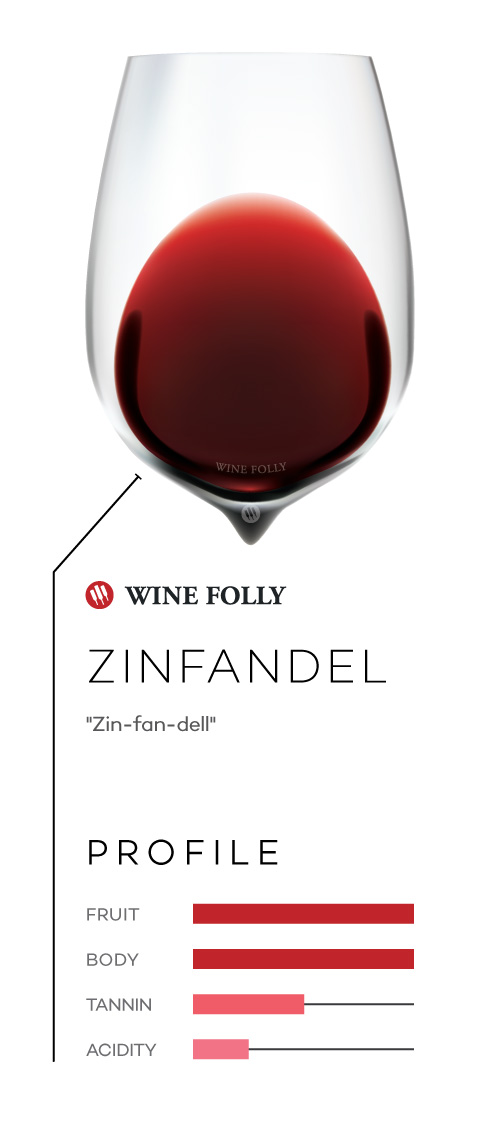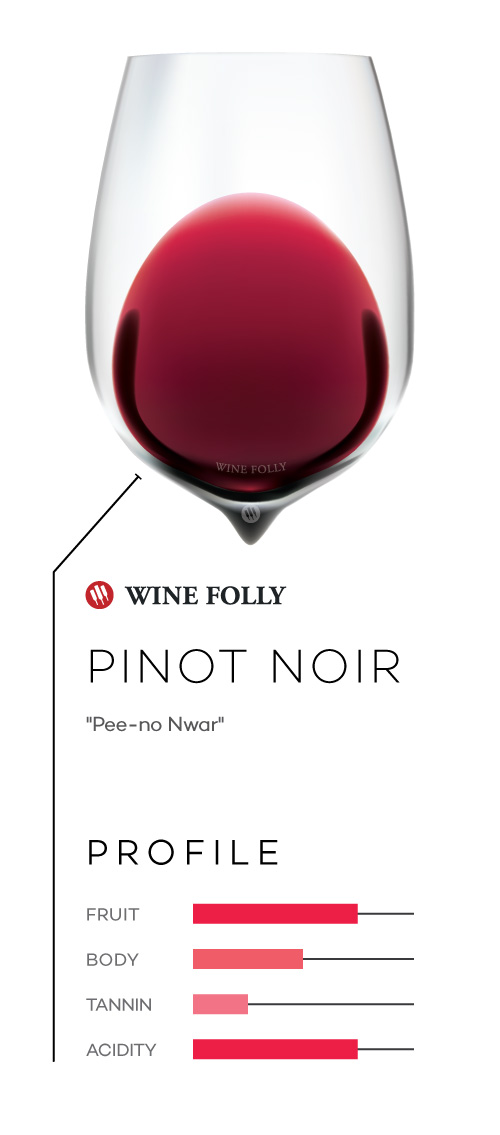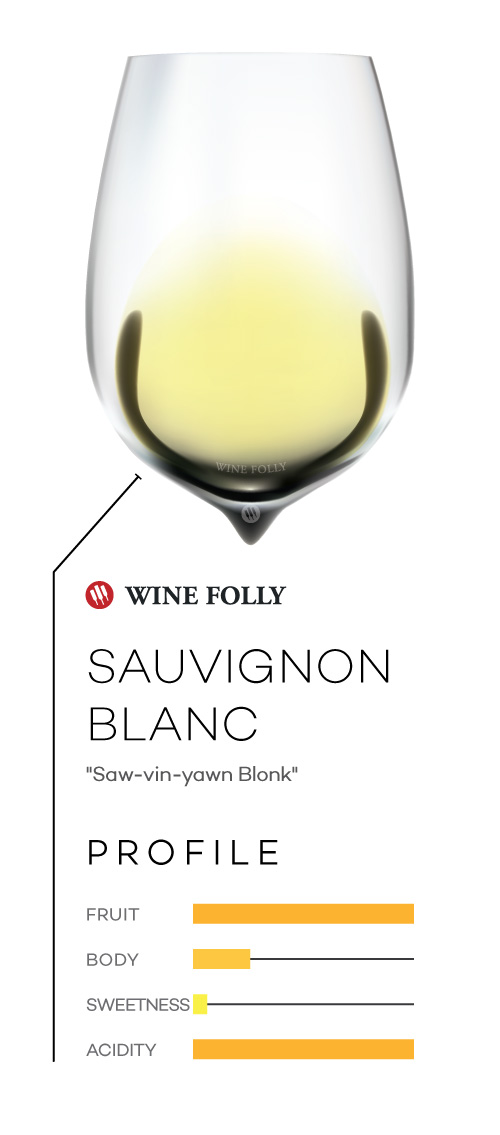Wine is made with grapes, but not typical table grapes you’ll find at the grocery store. Different types of wine come from various wine grapes (Latin name: Vitis vinifera), which have thick skins, are small, sweet, and contain seeds.
There are many kinds of wine grapes (over a thousand), but here are some common choices you’ll find in the grocery store.

Common Types of Wine
The eight wines included in this article represent six of the nine styles of wine.
Trying all eight wines will give you an excellent example of the potential range of flavors found in all wine.
Each wine listed below also includes alternative varieties that taste similar. So, if you prefer a particular wine, you might also like its alternatives.

Cabernet Sauvignon
“Kab-er-nay Saw-vin-yawn”
Taste: Black cherry, black currant, baking spices, and cedar oak.
Style: Full-bodied red wine.
Description: Cabernet Sauvignon is a full-bodied red grape first heavily planted in the Bordeaux region. Today, it’s the most popular wine variety in the world!
Wines are full-bodied with bold tannins and a long persistent finish driven mainly by the higher levels of alcohol and tannin that often accompany these wines.
Food Pairing: lamb, beef, smoked meats, firm cheeses like aged cheddar and hard cheeses like Pecorino.
Learn more about Cabernet Sauvignon
Great Alternatives to Cabernet Sauvignon
- Merlot: Middleweight, lower in tannins (smoother), with a more red-fruited flavor profile.
- Cabernet Franc: Light to middleweight, with higher acid and more savory flavors, one of Cabernet Sauvignon’s parent grapes.
- Carménère: Usually from Chile, very similar to Merlot in body, but with the aggressive savory flavors of Cabernet Franc.
- The Bordeaux Blend: Usually dominant to Cabernet Sauvignon or Merlot, but also includes any of the other Bordeaux varieties.

Syrah
“Sear-ah” (aka Shiraz)
Taste: Blueberry, plum, tobacco, cured meat, black pepper, and violet.
Style: Full-bodied red wine.
Description: Syrah (aka Shiraz) is a full-bodied red wine that’s heavily planted in the Rhône Valley in France and Australia. The wines have intense fruit flavors and medium-weight tannins. Syrah is commonly blended with Grenache and Mourvèdre to create the red Rhône blend. The wine often has a meaty (beef broth, jerky) quality.
Food Pairing: lamb, beef, smoked meats; Mediterranean, French, and American firm cheeses like white cheddar, and hard cheeses like Spanish Manchego.
Great Alternatives to Syrah
- Malbec: (Argentina) More black-fruited, often with more aggressive oak usage, less meaty, but with more coffee and chocolate flavors.
- Petite Sirah: (United States) This grape has no genetic relation to Syrah but has even more aggressive tannin and a fuller body.
- Monastrell: More broad texture, with similar meaty notes, but more of a mixture of red and black fruits.
- Pinotage: (South Africa) Similar in terms of body, with even more intense, smoky notes.

Zinfandel
“Zin-fan-dell”
Taste: A broad, exotic array of fruits from stone (overripe nectarine) to red (raspberry, sour cherry), to blue (plum, blueberry), to black (blackberry, boysenberry), Asian 5-spice powder, and sweet tobacco.
Style: Medium-bodied to full-bodied red wine.
Description: Zinfandel (aka Primitivo) is a medium-bodied red wine that originated in Croatia. Wines are fruit-forward and spicy with a medium-length finish. Zinfandel is a red grape that may be better known for its pink variation, White Zinfandel.
Food Pairing: chicken, pork, cured meat, lamb, beef, barbecue, Italian, American, Chinese, Thai, Indian, full-flavored cheese like cheddar and firm cheeses such as Manchego.
Great Alternatives to Zinfandel
- Grenache: More middle-weight and red-fruited flavors, with the meaty and peppery qualities you get with Syrah.
- Tempranillo: (Spain) Tempranillo has more savory cherry notes, as well as lower alcohol and body.
- GSM/Rhône Blend: This is a blend of Grenache, Syrah, and Mourvèdre originally from Rhône Valley of France. It’s very similar in terms of taste, but not usually as fruity.
- Carignan: This wine doesn’t have the cinnamon spice that Zinfandel often exudes. Expect more candied cranberry notes and sometimes a funky, meaty note.

Pinot Noir
“Pee-no Nwar”
Taste: Very red fruited (cherry, cranberry) and red-floral (rose), often with appealing vegetal notes of beet, rhubarb, or mushroom.
Style: Lighter-bodied red wine.
Description: Pinot Noir is a dry, light-bodied red that was first widely planted in France. The wines typically have higher acidity and a soft, smooth, low-tannin finish.
Food Pairing: chicken, pork, veal, duck, cured meat, French, German, cream sauces, soft cheeses, nutty medium-firm cheeses like Gruyère.
Great Alternatives to Pinot Noir
- Gamay: Lighter, juicier, more floral, with subtle herbal notes on the finish. Look for wines labeled “Beaujolais” from France.
- Schiava: (Italy) A rare find from Trentino-Alto Adige with candied cherry, rose hip, and allspice notes.

Chardonnay
“Shar-dun-nay”
Taste: Yellow citrus (Meyer lemon), yellow pomaceous fruits (like yellow pear and apple), tropical fruits (banana, pineapple), and often a touch of butterscotch, vanilla or toasted caramel notes from oak.
Style: Medium- to full-bodied white wine.
Description: Chardonnay is a dry, full-bodied white wine that was planted in large quantities for the first time in France. When oak-aged, Chardonnay will have spicy, bourbon-y notes. Unoaked wines are lighter and zesty with apple and citrus flavors. Chardonnay is the white grape of Burgundy.
Food Pairing: lobster, crab, shrimp, chicken, pork, mushroom, cream sauces, soft cheeses such as triple cream brie, and medium-firm cheeses like Gruyère.
Great Alternatives to Chardonnay

Sauvignon Blanc
“Saw-vin-yawn Blonk”
Taste: Aggressively-citrus-driven (grapefruit pith), with some exotic fruits (honeydew melon, passion fruit, kiwi) and always an herbaceous quality (grass, mint, green pepper).
Style: Light- to medium-bodied white wine.
Description: Sauvignon Blanc is a dry white grape first widely planted in France. Wines are tart, typically with herbal, “green” fruit flavors.
Food Pairing: fish, chicken, pork, veal, Mexican, Vietnamese, French, herb-crusted goat cheese, nutty cheeses such as Gruyère.
Learn more about Sauvignon Blanc
Great Alternatives to Sauvignon Blanc
- Vermentino: from Italy is less herbaceous, but with more appealing, bitter flavors (bitter almond).
- Verdejo: from Spain is almost identical, although sometimes fuller in body.
- Grüner Veltliner: from Austria has more savory vegetable notes (arugula, turnip, white pepper).
Pinot Gris
“Pee-no Gree” (aka Pinot Grigio)
Taste: Delicate citrus (lime water, orange zest) and pomaceous fruits (apple skin, pear sauce), white floral notes, and cheese rind (from lees usage).
Style: Light-bodied white wine.
Description: Pinot Gris is a dry, light-bodied white grape that is planted heavily in Italy, but also in France and Germany. Wines are light to middle-weight and easy drinking, often with some bitter flavor on the palate (bitter almond, quinine).
Food Pairing: Salad, delicate poached fish, light and mild cheeses.
Great Alternatives to Pinot Gris
- Albariño: from Spain is similar but has more acid and more citrus-driven aromatics (tangerine, orange juice) and floral aromatics.
- Soave: The grape is Garganega, but often with a more bruised and oxidized apple character, still relatively bitter.
- Melon: The grape is Melon de Bourgogne, and the wine region is called Muscadet in France. It’s often much higher in acidity, but with heavy lees and relatively neutral flavor.

Riesling
“Reese-ling”
Taste: Citrus (kefir lime, lemon juice) and stone-fruit (white peach, nectarine) always feature prominently. However, there are also usually floral and sweet herbal elements as well.
Style: Floral and fruit-driven aromatic white that comes in variable sweetness. Some producers choose not to ferment all the grape sugar, therefore making the wine in an “off-dry” style.
Description: Always very high in acid, when made as a table wine, Rieslings can be harmoniously sweet (sweet and sour) or dry (very acidic). The wine is polarizing because some people find dry styles too acidic and sweet styles too cloying, but sweetness is always a wine-making decision and is not inherent to the grape.
Food Pairing: chicken, pork, duck, turkey, cured meat, Indian, Thai, Vietnamese, Moroccan, German, washed-rind cheeses and fondue.
Great Alternatives to Riesling
- Moscato: Less acidic with a much more aggressively floral flavor profile.
- Gewürztraminer: richer, with less acid and more broad texture, rose candy and lychee are typical aromatics.
- Torrontés: Related to Moscato, but always in a dry style, more full-bodied and bitter.
- Chenin Blanc: Also very acidic and made in sweet and dry styles, but much more savory with more apple-y, savory aromatics.
